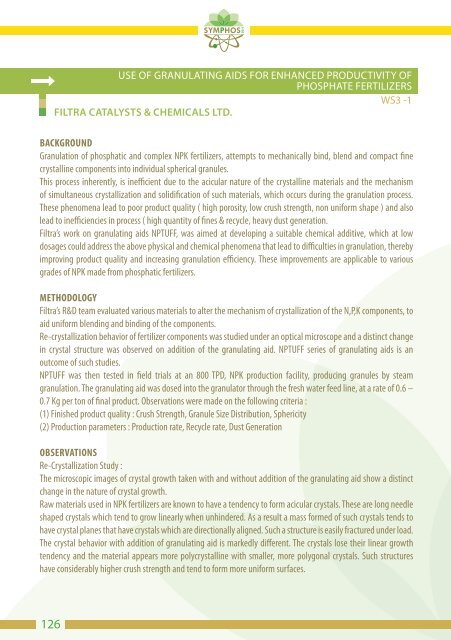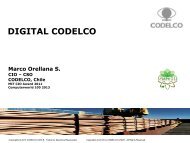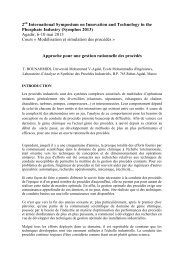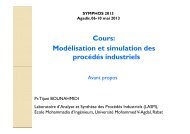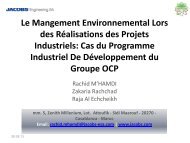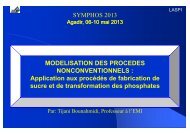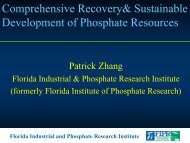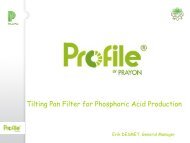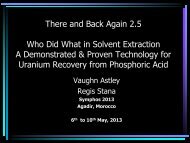Abstract SYMPHOS 2011
Abstract SYMPHOS 2011
Abstract SYMPHOS 2011
Create successful ePaper yourself
Turn your PDF publications into a flip-book with our unique Google optimized e-Paper software.
BACKGROUND<br />
Granulation of phosphatic and complex NPK fertilizers, attempts to mechanically bind, blend and compact fine<br />
crystalline components into individual spherical granules.<br />
This process inherently, is inefficient due to the acicular nature of the crystalline materials and the mechanism<br />
of simultaneous crystallization and solidification of such materials, which occurs during the granulation process.<br />
These phenomena lead to poor product quality ( high porosity, low crush strength, non uniform shape ) and also<br />
lead to inefficiencies in process ( high quantity of fines & recycle, heavy dust generation.<br />
Filtra’s work on granulating aids NPTUFF, was aimed at developing a suitable chemical additive, which at low<br />
dosages could address the above physical and chemical phenomena that lead to difficulties in granulation, thereby<br />
improving product quality and increasing granulation efficiency. These improvements are applicable to various<br />
grades of NPK made from phosphatic fertilizers.<br />
METHODOLOGY<br />
Filtra’s R&D team evaluated various materials to alter the mechanism of crystallization of the N,P,K components, to<br />
aid uniform blending and binding of the components.<br />
Re-crystallization behavior of fertilizer components was studied under an optical microscope and a distinct change<br />
in crystal structure was observed on addition of the granulating aid. NPTUFF series of granulating aids is an<br />
outcome of such studies.<br />
NPTUFF was then tested in field trials at an 800 TPD, NPK production facility, producing granules by steam<br />
granulation. The granulating aid was dosed into the granulator through the fresh water feed line, at a rate of 0.6 –<br />
0.7 Kg per ton of final product. Observations were made on the following criteria :<br />
(1) Finished product quality : Crush Strength, Granule Size Distribution, Sphericity<br />
(2) Production parameters : Production rate, Recycle rate, Dust Generation<br />
OBSERVATIONS<br />
Re-Crystallization Study :<br />
The microscopic images of crystal growth taken with and without addition of the granulating aid show a distinct<br />
change in the nature of crystal growth.<br />
Raw materials used in NPK fertilizers are known to have a tendency to form acicular crystals. These are long needle<br />
shaped crystals which tend to grow linearly when unhindered. As a result a mass formed of such crystals tends to<br />
have crystal planes that have crystals which are directionally aligned. Such a structure is easily fractured under load.<br />
The crystal behavior with addition of granulating aid is markedly different. The crystals lose their linear growth<br />
tendency and the material appears more polycrystalline with smaller, more polygonal crystals. Such structures<br />
have considerably higher crush strength and tend to form more uniform surfaces.<br />
126<br />
USE OF GRANULATING AIDS FOR ENHANCED PRODUCTIVITY OF<br />
PHOSPHATE FERTILIZERS<br />
WS3 -1<br />
FILTRA CATALYSTS & CHEMICALS LTD.


